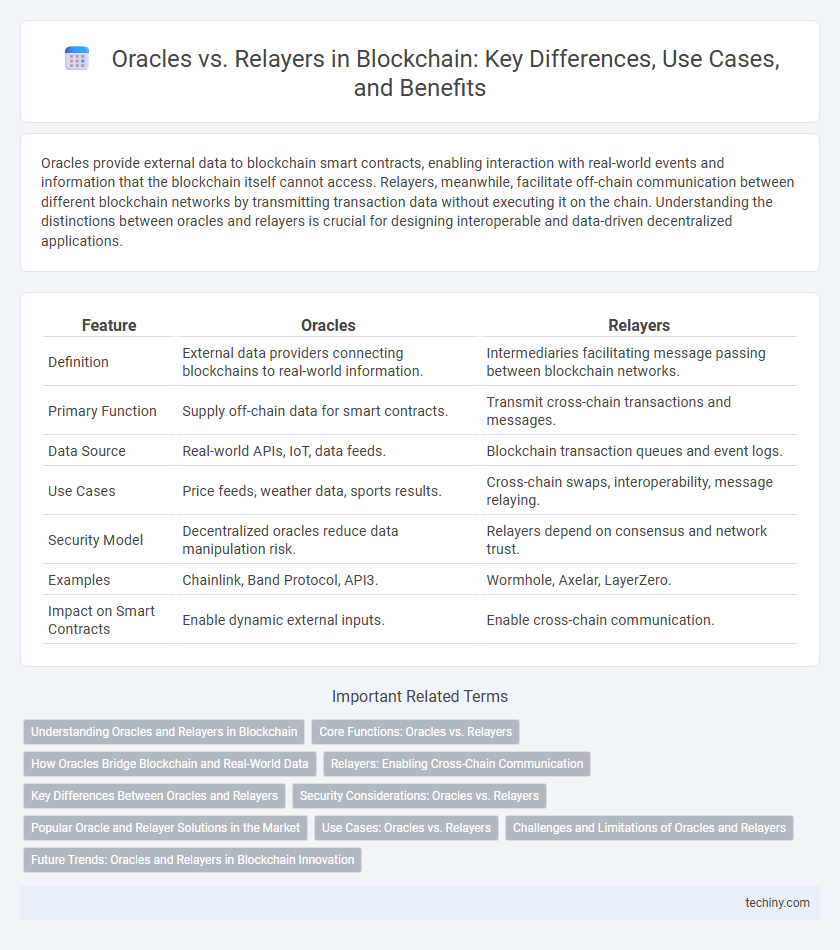Oracles provide external data to blockchain smart contracts, enabling interaction with real-world events and information that the blockchain itself cannot access. Relayers, meanwhile, facilitate off-chain communication between different blockchain networks by transmitting transaction data without executing it on the chain. Understanding the distinctions between oracles and relayers is crucial for designing interoperable and data-driven decentralized applications.
Table of Comparison
| Feature | Oracles | Relayers |
|---|---|---|
| Definition | External data providers connecting blockchains to real-world information. | Intermediaries facilitating message passing between blockchain networks. |
| Primary Function | Supply off-chain data for smart contracts. | Transmit cross-chain transactions and messages. |
| Data Source | Real-world APIs, IoT, data feeds. | Blockchain transaction queues and event logs. |
| Use Cases | Price feeds, weather data, sports results. | Cross-chain swaps, interoperability, message relaying. |
| Security Model | Decentralized oracles reduce data manipulation risk. | Relayers depend on consensus and network trust. |
| Examples | Chainlink, Band Protocol, API3. | Wormhole, Axelar, LayerZero. |
| Impact on Smart Contracts | Enable dynamic external inputs. | Enable cross-chain communication. |
Understanding Oracles and Relayers in Blockchain
Oracles in blockchain serve as trusted data providers that securely relay real-world information to smart contracts, enabling automated decision-making based on external inputs. Relayers facilitate off-chain transaction submission and communication between users and blockchain networks, enhancing scalability and efficiency by reducing on-chain congestion. Understanding the distinct roles of oracles and relayers is crucial for optimizing decentralized applications' accuracy and performance within the blockchain ecosystem.
Core Functions: Oracles vs. Relayers
Oracles provide external data inputs to smart contracts by fetching and verifying real-world information, enabling blockchains to interact with off-chain data such as price feeds, weather reports, and event outcomes. Relayers specialize in transmitting transactions or messages between different blockchain networks, facilitating cross-chain communication and interoperability by securely forwarding validated data from one chain to another. While oracles enrich smart contracts with trusted external data, relayers act as conduits that maintain seamless blockchain-to-blockchain connectivity and transactional integrity.
How Oracles Bridge Blockchain and Real-World Data
Oracles serve as critical intermediaries that connect blockchain networks with real-world data, enabling smart contracts to access external information such as market prices, weather conditions, and event outcomes. Unlike relayers, which primarily facilitate transaction messaging between blockchains, oracles fetch and verify off-chain data to ensure the accuracy and reliability of inputs governing decentralized applications. This bridging function empowers blockchain ecosystems to execute complex, data-driven logic that extends beyond the limitations of on-chain information.
Relayers: Enabling Cross-Chain Communication
Relayers function as essential intermediaries in blockchain ecosystems, facilitating secure cross-chain communication by transmitting transaction data between distinct networks without relying on external data sources. Unlike oracles, which provide off-chain real-world data to smart contracts, relayers focus on verifying and forwarding on-chain events to enable interoperability between heterogeneous blockchains. Their role ensures seamless asset transfers and data exchange across decentralized platforms, enhancing scalability and user experience within multi-chain architectures.
Key Differences Between Oracles and Relayers
Oracles and relayers serve distinct roles in blockchain ecosystems, where oracles provide external data feeds to smart contracts, enabling real-world information integration, while relayers facilitate transaction broadcasting and order matching off-chain for decentralized exchanges. Oracles connect blockchains to outside data sources such as price feeds, weather, or events, ensuring accurate input for contract execution, whereas relayers focus on improving transaction efficiency and scalability by handling off-chain activities and submitting aggregated data back on-chain. Key differences also lie in trust models: oracles often rely on data providers or decentralized consensus for data validity, while relayers emphasize low latency and transaction ordering within the network.
Security Considerations: Oracles vs. Relayers
Oracles and relayers play critical roles in blockchain ecosystems by facilitating off-chain data integration, but their security models differ significantly. Oracles provide trusted external data feeds, often requiring robust encryption and consensus mechanisms to prevent data manipulation or oracle hijacking, while relayers emphasize secure transaction forwarding and fraud-proof mechanisms to maintain integrity in Layer 2 solutions or cross-chain communications. Ensuring decentralized, cryptographically verified inputs is crucial for both oracles and relayers to prevent single points of failure and maintain overall blockchain network security.
Popular Oracle and Relayer Solutions in the Market
Chainlink stands out as the most popular oracle solution, providing secure and decentralized off-chain data feeds to smart contracts. On the relayer side, projects like Connext and Hop Protocol facilitate efficient cross-chain transactions by bridging assets and messages across different blockchains. Both oracles and relayers play critical roles in enhancing blockchain interoperability and real-world data integration.
Use Cases: Oracles vs. Relayers
Oracles provide external data feeds to smart contracts, enabling applications like decentralized finance (DeFi) price feeds, insurance claim verification, and supply chain tracking. Relayers facilitate off-chain transaction aggregation and submission on layer-2 solutions, optimizing scalability for use cases such as decentralized exchanges (DEXs) and payment channels. Both enhance blockchain interoperability but serve distinct roles in data integration versus transaction throughput.
Challenges and Limitations of Oracles and Relayers
Oracles face challenges such as data accuracy, security vulnerabilities, and centralization risks, which can compromise smart contract reliability. Relayers encounter limitations including high operational costs, latency issues, and reliance on trust assumptions that may affect transaction transparency. Both mechanisms struggle with scalability and integration complexities, impacting their efficiency in decentralized ecosystems.
Future Trends: Oracles and Relayers in Blockchain Innovation
Oracles and relayers are evolving as critical components in blockchain innovation by enhancing interoperability and enabling real-world data integration for smart contracts. Future trends indicate increased use of decentralized oracles with enhanced security protocols and the rise of relayers facilitating cross-chain communication and coordinated transaction ordering. Advancements in these technologies will drive scalability, reduce latency, and expand the practical applications of blockchain networks.
Oracles vs Relayers Infographic

 techiny.com
techiny.com